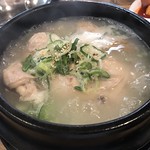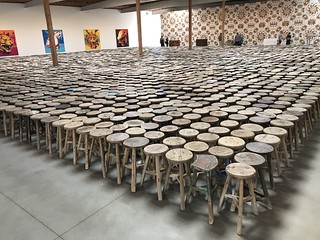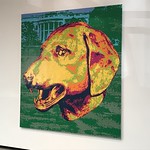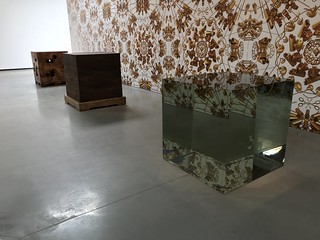Today’s off-Friday explorations took me to Koreatown for lunch, and then to the Ai Weiwei: Zodiac exhibition at the new Jeffrey Deitch Gallery. In Koreatown, as I’ve learned, many of the really good places have one dish that they specialize in, and which may be all they offer. Today was one of those. Buil Samgye Tang (the signage was mostly in Korean) serves only samgye-tang, a chicken rice soup loaded up with all sorts of roots and herbs that are meant to cure colds and hangovers and assure good health. The basic model is a hot iron pot of boiling broth with a ginger-and-garlic-stuffed whole young chicken, rice, mung beans, jujube (a Korean date), and ginseng. The more deluxe versions add various other folk pharmaceuticals such as milk vetch (an herb) and ground deer antlers. A bowl of sea salt on the table allows you to season to taste. And as if a whole chicken rice pot isn’t enough, the meal comes with a traditional Korean plate of banchans to start – kim chee, pickled turnips, chicken gizzard bites, and crudites with a spicy-sweet soy paste. Ginger tea is served to wash it all down. The Korean staff were assiduously polite, with lots of smiling and bowing.
After lunch, I headed to the new Jeffrey Deitch Gallery in Hollywood. The gallery is in a former warehouse space that has been lightened up with paint and indirect natural light for optimal viewing in one very large space. Which is just what the featured Ai Weiwei work, Stools (2013), required. The work comprises nearly 3,000 wooden stools from the Ming and Qing dynasties collected from northern China. Most of the stools have the same basic three-legged design with a round seat, but every so often one varies in shape, design, or material. There are subtle differences in dimension, age, wear, and so on. The work fills an area 72-feet square. It gives the impression of a crowd where at first everyone in the crowd looks the same, but then you start to notice subtle differences. Its vastness invites you to engage with it from all sides, and to approach it at different levels, the pattern of its ordered arrangement creating all sorts of lines. It's surprising what a simple concept can do.
On two walls enclosing the stools are twelve very large works representing the twelve signs of the Chinese zodiac overlaid on world landmarks from major cities. These works read initially as paintings, but a closer examination reveals them to be constructed from LEGOs. One wonders if there is particular meaning in which animal overlays which city. The dragon overlays Beijing, with a small self-portrait of the artist worked in, swearing. A rather rabid looking dog overlays the White House. Hmm. On a third wall is a work entitled The Animal That Looks Like a Llama But is Really an Alpaca (2015), which is literally wallpaper. At first glance, it looks like classic French ormolu patterns, gilded objects in ornate designs. On closer inspection, one discovers that the objects are handcuffs and surveillance cameras, an ominous illustration of the artist's years of house arrest in his native China. Along this wall are five sculptural works, each a cube exactly one cubic meter in dimension, but each of different materials. Here Weiwei plays with the concept of a cubic meter, a standard measurement for shipping cargo, but each cube is of very different materials. One is wooden and forms an elaborate puzzle box. Another is a dark mass, which when you get close enough to see and smell it, turns out to be a huge block of tea. Another is perhaps the world's largest crystal, perfectly transparent, and bending light in all sorts of fun ways that beg for investigation. A solid white marble cube has brain coral-like carvings in it to give it texture. The fifth cube is a frame, made of exquisite blue-patterned porcelain. Near the front, Grapes (2017) takes a few more of those wooden stools, but reassembles them into an integrated spheroid, legs all radiating outward, looking almost like a creature that could start rolling. It's fascinating to look closely at how the stools were integrated, like a chain of Siamese twins, with the third leg of one being the first leg of another, and so on.
I was thrilled to enjoy these works of such a remarkable artist, and to enjoy them in an appropriately lit and capacious space, and frankly to have had the gallery nearly to myself for a time. Though I have to confess I'm still new to the private art gallery thing, and a bit intimidated. I mean, it's not a public museum, so isn't it really meant for people who might conceivably be thinking of purchasing thsee works? But in exhibitions like these, are the works even really on offer? I mean, some of them are monumental. If one is rich enough to buy something like Stools from a world-renowned artist, then I suppose one is rich enough to build a space to house it? Off to one side of the gallery entrance, there was a small desk where sat Jeffrey Deitch himself (I recognized the former MOCA director from photos in the LA Times) and a couple of assistants. I didn't approach them, and they didn't approach me. But at some point, I did notice that when certain other people entered, he would pop up and greet them. And at one point, I was close enough to overhear some conversation. They were breezily talking about who they'd met at Davos or the latest TED talk, or how they just had lunch with Frank Gehry. Deitch asked one woman if he had a current address for her. "Oh, well sometimes I'm in New York," she replied, "but sometimes I'm in the house in France, or in Switzerland. It's best just to mail me at the Foundation." Wow. Different circles than I'll ever run in. But I guess it's because of people like them that galleries like this can exist, and I can get to enjoy them.
Friday, November 02, 2018
Subscribe to:
Post Comments (Atom)





No comments:
Post a Comment